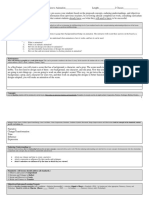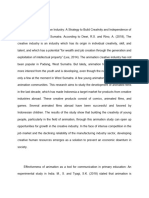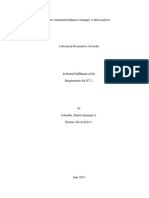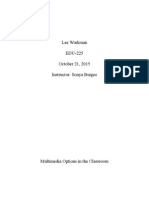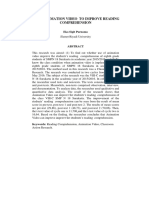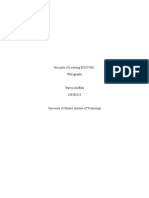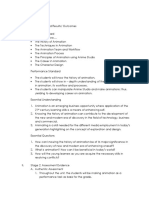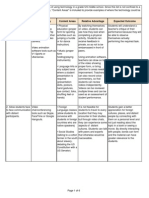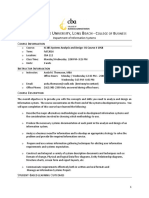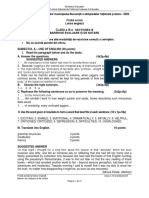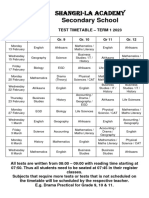Features
to encourage slowmations (studentgenerated animations) of science concepts
By Garry Hoban and Wendy Nielsen
Slowmation (abbreviated from Slow Animation) is a simplified way of making an animation that enables students to create their own as a new way of learning about a science concept. When students make a slowmation, they create a sequence of five multimodal representations (the 5 Rs) with each one contributing to the learning process in particular ways: Representation 1 - Background Representation 2 - Storyboard Representation 3 - Models Representation 4 - Digital Photographs Representation 5 - The Animation The 5 Rs help students to develop understanding of a science concept by encouraging them to create a stop-motion animation to explain it.
The 5 Rs: A new teaching approach
intRoduCtion
The world-wide explosion in personal digital technologies offers increasing opportunities for students in primary or secondary schools to create their own digital media. Getting students to make a mini-movie about a science concept twenty years ago was unheard of because of the expense of acquiring a movie camera and a video player. Also, digital still cameras for personal use were science fiction. But times have changed. Nearly all students now have access to digital cameras (still or movie cameras), iPods for playing sound tracks and movies, and computers preloaded with free movie making software. It is therefore not surprising that the most popular web sites in the world Facebook, Wikipedia, MySpace and YouTube are all composed of user-generated content because of this widespread accessibility to personal media making technology. This exponential growth in personal digital technologies coincides with a growing body of research which suggests that getting students to create a multimodal representation of a science concept is a way to enhance learning (Ainsworth, 1999; Prain & Waldrip, 2006; Tyler & Prain, In Press). A representation is a sign that stands for something else and can be designed with different modes text, photographs, diagrams, voice, numbers, graphs or models. It is through developing a sign and thinking about its meaning that learners develop a better understanding of what it is meant to be representing. Importantly, research has shown that constructing a representation helps students to make meaning of a science concept and this is often preferential to students copying an expertgenerated representation from a text book, which is a common practice in classrooms (Hubber, Tytler, & Haslam, 2010; Waldrip, Prain, & Carolyn, 2010).
concept. But even with appropriate technology, making a conventional movie to explain a science concept could be difficult for students to create, because inanimate science objects do not move by themselves unless they are motorised. On the other hand, making a mini-movie using a stop-motion animation technique is feasible because it is the creator who manually moves the objects whilst taking the digital still photos. Furthermore, having students take digital still photos one by one instead of a continuous 30 frames/second in a video allows them to manipulate, think about, discuss and reconfigure the models as each still photo is taken. Clay animation (abbreviated to claymation) is the most common example of a stop-motion animation, but its use in school classrooms is rare. This is because it is very tedious and time consuming to make clay models and show their movement at 20-25 frames/second, which is the normal speed for animation. Even so, there have been several school-based action research studies in Australia using claymation to promote students literacy skills. One project, Clay Animation in the Primary Classroom, was conducted at Hawthorndene Primary School and investigated the use of clay animation as a teaching and learning approach to enhance outcomes for disengaged and underachieving students (Murtagh, 2004). Titles of the fictional QuickTime movies produced include aZoo Trip, Snakes, Hamburger and Elephant Sandwich. Another claymation project, Student Centred Curriculum Multiliteracies and Disengaged Learners, was conducted at Tintinara Area School to assist Year 4-6 boys to improve their literacy skills (Murray, Neville, & Webb, 2005). The boys created a sequence of representations by writing stories with a selected theme, designing them with a storyboard, constructing clay figures and backdrop scenes, using digital photography and then completed written evaluations. In the study, the targeted group of boys became aware of the importance of planning and structuring their narratives, which suggested the need for more explicit teaching of narrative structure so that children could enhance their stories.
student-GeneRated animations
With the worldwide surge in personal media-making technologies, it is now possible for students to make a mini-movie as a new way of learning about a science
Volume 56 | Number 3 | September 2010
teachingscience
33
�In both claymation projects described, however, there were difficulties in storing the clay models over extended periods of time because they dried out and there was a need for ongoing adult assistance. Furthermore, the production process was very time consuming needing up to two school terms to complete with students working on them once a week in special literacy lessons. Moreover, both projects were using claymation to promote students literacies and were not about representing science concepts. It appears, therefore, that there has been very little use of stop-motion animation as a teaching approach in school classes to promote student learning. Perhaps claymation in its conventional form is too complex or time-consuming for science teachers to organise or the content has not been suitable for this animation technique.
Technology - students use their own digital still cameras (set on low resolution) and free movie making software available on their computers (eg iMovie or SAM Animation on a Mac or Windows Movie Maker on a PC). In summary, slowmation greatly simplifies the process of making stop-motion animations by students manipulating 2D or 3D models often lying down on a flat surface, using accessible technology and requiring a tenth as many photos as a normal animation because they are played ten times slower at 2 frames per second. The result is a student-generated animation with images that move in slow-motion accompanied by a narration and labels to explain the movement or change like a narrated flip book.
slowmation: a simPliFied way to make an animation
Slowmation (abbreviated from Slow Animation) is a simplified way for primary or secondary students to make a stop-motion animation providing a new way for them to learn about a science concept (Hoban, 2005, 2007, 2009). Students can use their own digital still camera and free movie making software on their own computers to design a stop-motion animation. Creating a slowmation combines several media making techniques integrating features of clay animation, object animation and digital storytelling. Like clay animation (Witherspoon, Foster, Boddy, & Reynolds, 2004), slowmation uses a stop-motion technique involving the manipulation of models with a digital still photo taken of each manual movement. Like object animation, a range of materials can be used such as plastic models, wooden, paper or cardboard cutout models commonly found in primary classrooms (Laybourne, 1998). Similar to digital storytelling (Lambert, 2002), a key part of creating a slowmation is that a narration and existing photos can be added by students to explain the science concept as the models are animated. In summary, a slowmation displays the following features: Purpose - the intention of a slowmation is for students to learn about a science concept by making an animation to explain it. Its design can include a range of technological enhancements such as narration, music, existing photos, diagrams, models, labels, questions, static images, repetitions and characters to help explain the concept. Timing - slowmations are usually played slowly at 2 frames/second, not the usual animation speed of 20-24 frames/second, hence needing ten times fewer photos than in clay or computer animation and resulting in the name of Slow Animation or Slowmation. Materials - because models do not have to stand up, many different materials can be used such as soft play dough, plasticine, 2D pictures, drawings, written text, existing 3D models, felt, cardboard cut outs and natural materials such as leaves, rocks or fruit. Orientation - models are made in 3D and/or 2D and usually manipulated in the horizontal plane (on the floor or on a table) and photographed by a digital still camera mounted on a tripod looking down or across at the models, which makes them easier to make, move and photograph.
the 5Rs teaChinG aPPRoaCh
Research has shown that learners not only find the process of creating a slowmation engaging, but the creation process helps them to develop an understanding of a concept because they reflect upon it in multiple ways (Hoban, 2007; Hoban, McDonald and Ferry, 2009). This is because in creating a representation, students make meaning as they are thinking about the relationship between what they are making (the representation) and the concept or object they are trying to represent (the referent). This relationship of meaning making through creating a representation of an object or concept was first demonstrated by Peirce (1931) in his Semiotic Triad or Semiotic System shown in Figure 1. When designing a representation, therefore, students make meaning by checking the accuracy of the concept they are trying to represent by researching using the internet or books, or by discussing information with their peers or a teacher.
Referent
object or concept being represented
Representation
Sign created by learner
Interpretation by learner
Meaning
Figure 1: Peirces (1931) Triadic Model of a Semiotic System.
What is unique about the slowmation process, however, is that students are checking and discussing the accuracy through the construction of not one, but five representations. Moreover, each representation makes the students think about the concept in unique ways and with different modalities which is now explained in more detail.
Representation 1: Background
Students need enough background knowledge before designing an animation to explain a concept. This may involve students conducting research in order to be aware of information to identify a sequence that will involve change to be explained in the animation. Alternatively, a teacher may specifically instruct students about the basics of a particular concept.
Volume 56 | Number 3 | September 2010
34
teachingscience
�Features
The representation that students usually make in summarizing this information can be in the form of notes, a table, diagrams or graphs. The meaning from this representation is then transferred to the next representation, the storyboard.
Representation 5: The Animation
Students synthesise the previous steps as they download the photos to a computer, upload them into the software, edit them and add the narration. The process is not software specific so any movie making program on a PC or Mac computer can be used as shown in the free instructions available at the web site www.slowmation.com. A key part of this final process is that students need to ensure that the slow moving models shown in the photos, any text as in labels and the narration are coherent. As such, these different modes complement each other and enhance student learning in the construction process. In sum, each of the five representations is its own semiotic system or semiotic triad (Peirce, 1931) shown in Figure 1 as each representation is designed and made to show features of the referent (the science concept). What is key to the learning process in slowmation, is that meaning making is multiplied (Lemke, 1998) by being transferred from one representation to the next and enhanced with each representation having its own affordances that make the students think about the concept (referent) in particular ways. For example, the first representation, background, encourages students to summarise content from personal research or from being taught and this information then becomes the basis of the second representation, storyboard. This second representation has the affordance of requiring students to break down a concept into its chunks and then sequence them in a way that best explains the concept. The meaning from the storyboard is then used to guide the construction of the third representation, models, which has the affordance of making students think about each chunk and what it looks like. Once the models are made, students have to think about how the models move in relation to each other, which is the main affordance of the fourth representation, photographs. These digital images are then compiled in the final representation, the animation, which has the affordance of synthesizing the previous steps by having the students upload the photos into the software, edit them and add the narration to explain the concept being demonstrated. In particular, the slow-moving image created by the sequence of photographs needs to match the narration to provide the clearest explanation of the concept. It is in this final representation that the students have to ensure that the three modes involved models, text and narration fit together as a coherent whole. It is this combination of modes within representations that distinguishes slowmation from one-off studentgenerated representations such as in a table, a diagram or a sketch. A conceptual framework, showing a sequence of the five interconnected representations and how meaning is transferred and enhanced from one representation to another is shown in Figure 2. This
Representation 2: Storyboard
Students take information from the first representation and design a storyboard whereby the concept is broken down into several chunks or scenes and placed in a coherent sequence, which involves creating the modalities of sketching diagrams and sometimes writing a narration. Each chunk then needs to be sequenced to show the anticipated actions or explanations in a coherent story. We recommend that the students also script their narration to accompany each chunk as the modal representation of text informs the sketches and vice versa.
Representation 3: Models
As guided by the storyboard, the students make 2D and/or 3D models to represent the chunks or parts of the concept being represented. Existing models that are readily available in a classroom can be used or new models can be made with play dough, plasticine and so on. This representation involves the students thinking about each chunk of the concept in concrete ways and how to best represent it in a sequence which is brought to life through model construction. Further to this, making models also raises questions as to what the actual feature of the referent being represented looks like and often involves checking with the internet about particular features. This form of representation often appeals to those students who are hands-on learners and engage in learning by making concrete materials.
Representation 4: Digital Photographs
Creating the fourth representation involves students taking digital images of the models as they are manually moved to show change in the concept being demonstrated. This representation raises questions about how the actual model moves in real life and how this can be best simulated. The usual set up or workstation involves having a digital still camera mounted on a tripod looking vertically down at the models on a table or the floor or across at existing plastic models. This can be done at one workstation at the front of a classroom or using several workstations. If tripods are limited, digital still cameras can be taped to two rulers that are secured to a desk with the camera looking down at the models on a floor. Key to the digital imaging in a slowmation is making small manual movements of the models to match the desired effect of representing movement or change according to the sequence in the storyboard.
Referent
Referent
Referent
Referent
Referent
Rep. 1
Meaning
Rep. 2
Meaning
Rep. 3
Meaning
Rep. 4
Meaning
Rep. 5
Meaning
Figure 2: The Five Rs Conceptual Framework for Creating a Slowmation.
Volume 56 | Number 3 | September 2010
teachingscience
35
�diagram is an adaptation of Peirces (Peirce, 1931) semiotic triangle from Figure 1 showing how meaning from designing one representation is transferred, used and enhanced across the sequence of five representations. Finally, because the animation is easily shared by showing it on a computer or uploading to the internet, it can be discussed by peers and the teacher, or reviewed by a content expert to provide the students with feedback on the scientific accuracy and presentation of the animation. It should be noted that Figure 2 does not show all the dynamics of this process as the design and make process is iterative, but the most important part of meaning making is a progression of ideas from one representation to the next.
Sometimes getting school children to represent their ideas in this way reveals their alternative conceptions which are then clarified by the teacher as a result of the children showing and explaining their slowmation to the class (Keast, Cooper, Berry, Loughran, & Hoban, 2009). One example is now provided by a primary teacher, Wendy, who used the new teaching approach in a primary school to teach the topic of life cycles to her year 2/3 class. Wendy had planned to teach the topic of life cycles over four weeks with two science lessons each week. In the unit, the students covered several life cycles such as butterflies, silk worms and beans. In the life cycle of beans, the students formed pairs and each pair grew a bean seed in a cup and documented the growth of the bean seed in a diary. At the end of the topic, she organised the students as a jigsaw to make a class slowmation over four fifty minute lessons as a way of summarizing what the students had learned during the topic. The class was divided into five groups that represented the different parts of the bean seed life cycle: (i) seed germination; (ii) seed growth; (iii) seedlings (iv) flowering; and (v) forming seeds. The first lesson involved the students constructing a storyboard based on the documentation of results in their bean seed diary. The second lesson involved the students making models and the third lesson involved the students taking photos of the models as they were manually moved. The fourth lesson involved recording the narration as a whole class. The sequence of representations and related action by the students is shown in Table 1.
examPle oF the 5 Rs teaChinG aPPRoaCh in a PRimaRy ClassRoom
Over the last three years, over 600 slowmations have been made by preservice teacher education students at The University of Wollongong and Monash University through a national research project. As a consequence of learning about this new teaching approach in their science methods classes, some of the now graduated preservice teachers are using the 5Rs as a new teaching approach in school classrooms and encouraging school children to make their own animations of science concepts. In a primary school context, the 5Rs teaching approach is usually used at the end of a topic as a summative assessment task to ascertain what children have learned about the topic.
REPRESENTATION WITH MODES
Representation 1: Background text diagrams
ACTION
EXAMPLE
The children kept a bean diary documenting the growth of the bean seeds over a period of three weeks.
Representation 2: Storyboard diagrams text
At the end of the three weeks the students designed a storyboard showing the different stages of the bean seed germination.
Representation 3: Models 3D models using play dough
In a class jigsaw, each of the five groups of students were allocated a different part of the bean life cycle to create models out of playdoughgermination, seed growth, seedlings, flowering, forming seeds.
Representation 4: Photographs digital still images of the small manual movements
During one lesson, each group is called out in turn to take photos of their play dough models as they are moved manually.
Representation 5: Animation computer generated digital animation narration
The teacher takes 20 minutes to download the photos onto her computer and edit them using the animation software to create the animation. The teacher then got the class to record a group narration.
Table 1: Five Connected Multimodal Representations when Creating a Slowmation.
36
teachingscience
Volume 56 | Number 3 | September 2010
�Features
Some of these have also been uploaded to YouTube. In a primary classroom, examples have been made by students explaining life cycles, forces, seasons, weather systems, night and day, etc. In a secondary classroom, some examples have been to explain mitosis, meiosis, phagocytosis, chemical bonding, chemical equations and gene technology. Finally, we know from interviewing students before and after they create a slowmation, that the process often results in helping them to better understand a concept. What we do not know, however, is how constructing the modalities within each representation interrelate to influence learning. Therefore, further research is needed to drill down to better understand how these learning processes interrelate. Research studies are under way to better understand how students learn about particular concepts by videoing students over several hours as they create a slowmation and encouraging them to think aloud. We are hoping that further technological advances will make animation even simpler so that slowmation may become a common teaching approach in schools as a new way for students to engage with science content by making their own digital media products to share with others.
Photo 1: Childrens bean seeds growing.
disCussion and ConClusion
Getting students to create an animation of a science concept has traditionally been too difficult to achieve in school classrooms either due to lack of equipment or the complexity of the process. Moreover, when an animation has been created by students, such as with claymation, it has usually been for the teaching of literacy or art, not for the teaching of science. Even so, using claymation in a classroom is often too tedious and time consuming to be commonly used as a teaching approach. Slowmation greatly simplifies the process of creating animations and so makes the use of animation as a teaching approach more feasible. Additionally, it is an approach that involves students thinking about content in multiple ways and incorporates many connected learning processes. The 5 Rs is a new teaching approach to guide primary or secondary students so that they can create an animation as a representation of their learning in several hours. It is best to teach students the creation process in a small way using only twenty photos, which can be done in about two hours, and then they are able to make their own slowmation to explain a concept. Furthermore, because the technology is easily accessible and familiar a digital still camera, a tripod and free movie making software students can design and construct the animation in a classroom and finish it at home, or better still, make one at home and bring it to school to show the class. The key point of this article is that creating a slowmation helps students learn about a science concept because they are constructing a sequence of five multimodal representations, which encourages them to think about a science concept in multiple ways. Furthermore, asking the students to create an animation that explains a science concept engages them in learning about the concept because they need to understand it before they can explain it. Importantly, each representation can involve the use of different modalities notes, digital images, sketches, models and voice, which should complement each other and so the process incorporates multiliteracies that are commonly used in the scientific community. Although this article explains slowmation and gives one example of using the 5 Rs in a primary school classroom, there have been many other examples in schools and in other subject areas besides science. Undertaking a Google search on the word slowmation provides many different examples of animations made by students in schools in Australia, the USA and Canada.
Volume 56 | Number 3 | September 2010
aCknowledGements
1. This research was funded from an Australian Research Council Discovery Grant, DP O8799119. Free examples, instructions and other resources can be viewed on the project web site www.slowmation.com. 2. The authors would like to thank Professor Vaughan Prain (LaTrobe University) and Professor Russell Tytler (Deakin University) who provided insightful guidance about the literature of representations. 3. The authors would like to thank Wendy Myers, the teacher who used the teaching approach of slowmation.
ReFeRenCes
Ainsworth, S. (1999). The functions of multiple representations. Computers and Education, 33, 131-152. Hoban, G. (2005). From claymation to slowmation: A teaching procedure to develop students science understandings. Teaching Science: Australian Science Teachers Journal, 51(2), 26-30. Hoban, G. (2007). Using slowmation to engage preservice elementary teachers in understanding science content knowledge. Contemporary Issues in Technology and Teacher Education, 7(2), 1-9. Hoban, G. (2009). Facilitating learner-generated animations with slowmation. In L. Lockyer, S. Bennett, S. Agostino & B. Harper (Eds.), Handbook of Research on Learning Design and Learning Objects: Issues, Applications, and Technologies (pp. 313-330). Hershey, PA: IGI Global. Hoban, G., McDonald, D., & Ferry, B. (2009). Improving preservice teachers science knowledge by creating, reviewing and publishing slowmations to teacher tube. Paper presented at the Proceedings of Society for Information Technology & Teacher Education International Conference Charlestown, SC. Hoban, G., McDonald, D., Ferry, B., & Hoban, S. (2009). Simplifying Animation to Encourage Preservice Teachers Science Learning and Teaching Using Slowmation. Paper presented at the EDMEDIA, Proceedings of World Conference on Educational Multimedia, Hypermedia and Telecommunications Honolulu, Hawaii. Hubber, P., Tytler, R., & Haslam, F. (2010). Teaching and learning about force with a representational focus: Pedagogy and teacher change. Research in Science Education, 40(1), 5-28.
teachingscience
37
�Keast, S., Cooper, R., Berry, A., Loughran, J., & Hoban, G. (2009). Using slowmation to stimulate thinking about pedagogical intent in science teaching and learning. Paper presented at the Annual Meeting of the American Educational Research Association. Lambert, J. (2002). Digital storytelling: Capturing lives, creating community. Berkeley, CA: Digital Diner Express. Laybourne, K. (1998). The animation book. New York: Three Rivers Press. Lemke, J. (1998). Multiplying meaning: Visual and verbal semiotics in scientific text. In J. R. Martin & R. Veel (Eds.), Reading science: Critical and functional perspectives on discourses of science (pp. 87-113). New York: Routledge. Murray, L., Neville, H., & Webb, M. (2005). Student centred curriculum-multiliteracies and disengaged learners. Retrieved 30th May, 2005, from http://www.tsof.edu.au/Projects/PLICT/Grants/ Reports04/murray.asp Murtagh, Y. (2004). Clay animation in the primary classroom. Retrieved 30th May, 2005., from http://www/tsof.edu.au/Projects/ PLICT/Grant/Reports03/bassham.asp Peirce, C. (1931). Logic as semiotic: The theory of signs. In B. Justus (Ed.), Philosophical writings of Peirce (1893-1910) (pp. 98-119). New York: Dover. Prain, V. (2006). Learning from writing in secondary science: Some theoretical and practical implications. International Journal of Science Education, 28(2-3), 179-201. Prain, V., & Waldrip, B. (2006). An exploratory study of teachers and students use of multi-modal representations of concepts in primary science. International Journal of Science Education, 28(15), 1843-1866.
Tyler, R., & Prain, V. (In Press). A framework for re-thinking learning in science from recent cognitive perspectives. International Journal of Science Education. Waldrip, B., Prain, V., & Carolan, J. (2006). Learning junior secondary science through multi-modal representations. Electronic Journal of Science Education, 11(1). Waldrip, B., Prain, V., & Carolyn, J. (2010). Using mulit-modal representations to improve learning in junior secondary science. Research in Science Education, 40(1), 65-80. Witherspoon, T. L., Foster, M. S., Boddy, G., & Reynolds, K. V. (2004). Clay animation: Encouraging visual literacy. Paper presented at the World Conference on Educational Multimedia, Hypermedia and Telecommunications, Lausanne, Switzerland. TS
aBout the authoRs:
Garry is an Associate Professor and Science Education Coordinator in the Faculty of Education at the University of Wollongong. He is the creator of slowmation which he developed over the last five years by researching his own teaching. Wendy is a lecturer in Science Education at the University of Wollongong. She has taught science in high schools and middle schools in Canada and America and completed her PhD at the University of British Columbia in 2009.
BACKYARD SCIENCE:
Primary Teaching resource
Good news for primary teachers with the launch of Backyard Science: Primary Teaching Resource (DVDROM), a high-quality interactive teaching and learning resource for non-specialist science educators. The resource is based on the Primary Connections 5Es teaching framework: Engage, Explore, Explain, Elaborate and Evaluate.
This innovative resource promotes the development of scientific literacy for children (Years 4-7) through a variety of teaching strategies, video clips, detailed notes and classroom experiments from the highly successful Backyard Science television series. It utilises digitised video clips of experiments conducted by kids for kids based on scientific discovery, investigation, problem solving and curiosity about our world. The Backyard Science: Primary Teaching Resource provides practical teaching ideas, including 40 experiments and related classroom activities with accompanying worksheets and science fact sheets. Additionally, the resource includes more than 70 digital video clips from the highly successful Backyard Science TV series. The resource also features classroom interactive games and quizzes using Kahootz 3 Xpressions. It encourages children to work independently with interactive and self-paced learning activities. The Backyard Science: Primary Teaching Resource (DVD-ROM) is now available for purchase from the ASTA office using the order form from the asta website or by calling the office on 02 6282 9377.
Available for purchase from ASTA
ONLY
(*+ $5 P&H ea includes GST)
60
To download an order form visit www.asta.edu.au
38
teachingscience
Volume 56 | Number 3 | September 2010
�Copyright of Teaching Science - the Journal of the Australian Science Teachers Association is the property of Australian Science Teachers Association and its content may not be copied or emailed to multiple sites or posted to a listserv without the copyright holder's express written permission. However, users may print, download, or email articles for individual use.










